

Gran Canaria is rich in marine life, with a huge variety of colours, shapes and species. The waters are warm and clear all the year round, and it's position in the Atlantic just off the coast of Africa gives the island a mix of species from Mediteranean, Carribean, African and Atlantic waters. Much of the island is also surrounded by a rock shelf with depths of between 20 and 40 meters, making it an ideal depth for recreational diving. When you add to this the stunning scenery that historical volcanic eruptions have produced, and the effects of the gulf stream, you get an island with a fascinating mix of excellent dive sites.
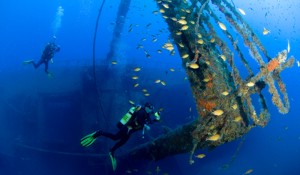
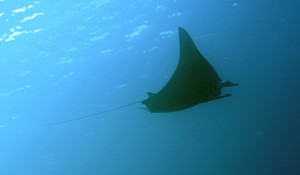
Gran Canaria is a small island (it would fit within the M25 motorway) so the
resorts and the best diving are all close to each other. The table below gives
typical drive times in minutes between the popular resorts (left) and main dive
sites (top).
| Arinaga | West Coast | Mogan | Las Palmas | |
| Playa del Ingles | 20 | 20 | 40 | 60 |
| Puerto Rico | 40 | 5 | 20 | 1:20 |
| Mogan | 60 | 20 | 5 | 1:40 |
You can do both types of dives in Gran Canaria with spectacular examples of each.
In the north near Las Palmas and on the west coast the best dives are accessed by
boat, while on the east coast the best diving on the island in the Arinaga Marine
Reserve is shore based, as all the marine life is close in to the shoreline.
The best wrecks in the area are accessed from Las Palmas, with the Kalais, Arona
and Frigorifica always popular. Several Dive schools in Las Palmas offer regular
excursions to them using RIBS and small day-boats.
Most of the schools on the island offer trips to the Arinaga Marine Reserve,
although only the local centers dive there every day. The best entry points are
2km from Arinaga, in an 'off-road' area where rugged vehicles and good local
knowledge are indispensible. If you hire a car on the island you should note that
most insurance policies do not cover you for off-road driving and you may not be
covered if you take your own vehicle onto these unmade roads.
Yes, several dive centres offer night dives if there is sufficient demand. At
night you will see species which are never visible during the day, such as
red-legged octopus, golden balearic congers, sea hares, squid, and sand crabs; and
can often find predators like rays, anglesharks and stargazers in water only 2-3m
deep. The best places for night dives are beaches with good access and
illumination, close to undersea reefs, such as El Cabrón in Arinaga,
Sardina del Norte and Las Canteras.
There are two main areas for wreck diving in Gran Canaria, the wrecks outside the
port of Las Palmas, and the wrecks of the west coast.
Around the port of Las Palmas there are several wrecks in the 20 to 35m depth
range, of which the Arona is the most famous, and one of the best dives. It lies on its side with the deck
of the Arona is at 25m and unlike many UK wrecks the superstructure has not been
swept, despite being just outside the harbour. This means that the intact
kingposts make a dramatic sight towering above the wreck and attracting thousands
of damselfish, wrasse and other species. Other popular wrecks include the Frigorifica at
32m, the Angela Pando, Upside-down wreck and Tres Barcos at
15-20m.
The other area with easy wreck diving is centered on Puerto Rico on the west
coast, where the wreck of the Cermona II lies just outside Mogan, and the wreck of
a Russian Hydrofoil (just outside El Pajar) are both dived on a regular basis.
Gran Canaria has other wrecks such as the famous Alphonso XII in 55m, and other
wrecks of the Gando Shoal, however tides are very strong, with narrow dive
windows, and access is difficult, and currently there are no dive centres which
organise trips to these.

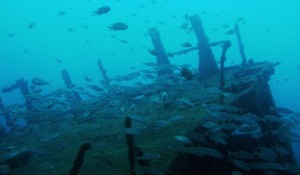
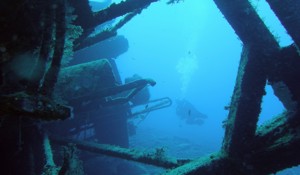
Gran Canaria is on the same lattitude as The Red Sea, Florida and the Sahara desert, and has a
similar sub-tropical climate. Daytime temperatures never drop below 14C in winter
and are usually in the 30's in the summer. Although very hot in summer, the
humidity is relatively low and this makes the temperatures more bearable. The
solar UV factor is very high however and a high factor sun cream is advised. For
much of the year the island comes under the effect of the 'trade winds', which
blow strongly from the North East, helping to keep the effective temperatures
down.
In addition, the Island has it's own 'micro-climate' caused by the volcanic
peaks and mountains in the centre. This is characterised by more cloud and lower
temperatures in the North, around the capital, Las Palmas; and more sun and
higher temperatures in the South and South West. Some days there is a 2C
difference between Las Palmas and the Airport; 2C between the airport and Playa
del Ingles and a 2-4C difference between Playa del Ingles and Puerto Rico. In
other words, actual temperatures in the tourist resorts can be 4-8C higher than
shown in the papers, on teletext or on the net for a Las Palmas temperature.
Yes, all the diving schools have equipment for hire which is suitable for this area. Most schools provide 5mm full wetsuits, and some offer full-foot boots for shore entries. It is possible to hire partial or full sets of equipment, but as there are almost no 'easy access' dive sites most schools only offer hire as part of a diving excursion, so that local bye-laws and regulations are observed, and the dive guides can lead you safely in and out of the water.
Yes, it is in fact an excellent place, with several professional photographers regularly using this area for photo shoots, and in 2005 two International Competitions were held here. The waters are clear, the area teems with life, and the light and current can be ideal for underwater photography. The best places for underwater photography are in the Arinaga Marine Reserve, The Pasito Blanco Reef, and the wrecks of Las Palmas.
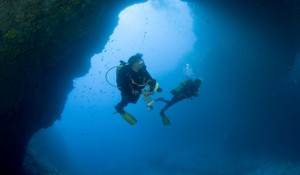
No, the Canaries are warmed by a branch of the Gulf Stream, and temperatures reach about 23-24C in late summer and rarely drop below 18C in the winter. We recommend that visitors use 5mm full wetsuits all the year around. The water is in fact coldest in late February/early March, and warmest in late Autumn (October). There are no restrictions on the use of gloves in winter.
Recreational diving has a very high safety record in Gran Canaria. Most sites are around a comfortable recreational depth of 20m, and give reasonable non-stop dive times. Gran Canaria has a modern, well equiped public health service, and several excellent private clinics. Always check that your travel insurance covers you for diving to recreational depths before leaving home. Over the last few years the number of fatalities has been very low at around 0.0001%, with most being attributed to heart attacks.
All the major tour operators in the UK offer packages to Gran Canaria, from most of the regional airports, including Cardiff, Leeds, Liverpool, Hull, Newcastle, Birmingham, East Midlands, Gatwick, Glasgow and Luton. Easyjet Jet2 and Ryanair also run a weekly services from Gatwick , Manchester, Leeds, Glasgow and other regional airports. You can either book seat only or as part of a package, giving you a range of options for getting to Gran Canaria. Most flights by the major tour operators fly on Saturday, Monday or Thursday.
For more options talk to your local travel agent or check on on-line booking sites.
You can get almost anything you want, with Hotels from the five star luxury of
the Gran Residencia down to self catering appartments or a luxury villa.
Most of the accomodation is located in either the Maspalomas area or the
Puerto Rico to Mogan coast.
Maspalomas includes the resorts of Playa del Ingles, Sonnenland, Meloneras,
Bahia Feliz, and San Agustin, and together they make up the second largest
tourist resort in Europe. However as everything is less than thirty years old,
the mix of high and low rise buildings, and an excellent road infrastructure
give the resort a much more relaxed feel than it's size would suggest.
Built around an old port Puerto Rico rises up the sides of a valley to give
most appartments a stunning sea view.
For detailed accomodation options talk to one of the major tour operators such
as Thomas Cook.'
Families will find plenty to amuse themselves in the main resorts in the south of the island - Playa del Ingles, Maspalomas, Puerto Rico and Mogan. There are three water parks, a Wild West theme park (Sioux City), a nature park (Palmitos Park) and the great beaches and Saharan dunes for which Gran Canaria has long been famous.
For those that want other sports you can play golf, go deep sea fishing, walk or cycle up the mountains, or take a camel or jeep safari and bump up and down them. Gran Canaria is also famous for the quality of the windsurfing, and lots more boat trips and watersports can be found in the south-west in the ports of Arguineguine, Puerto Rico and Mogan.
If the outdoor life is not for you then a trip to the capital, Las Palmas takes you to Europe's most southerly city, bustling with shops, museums, history and culture.